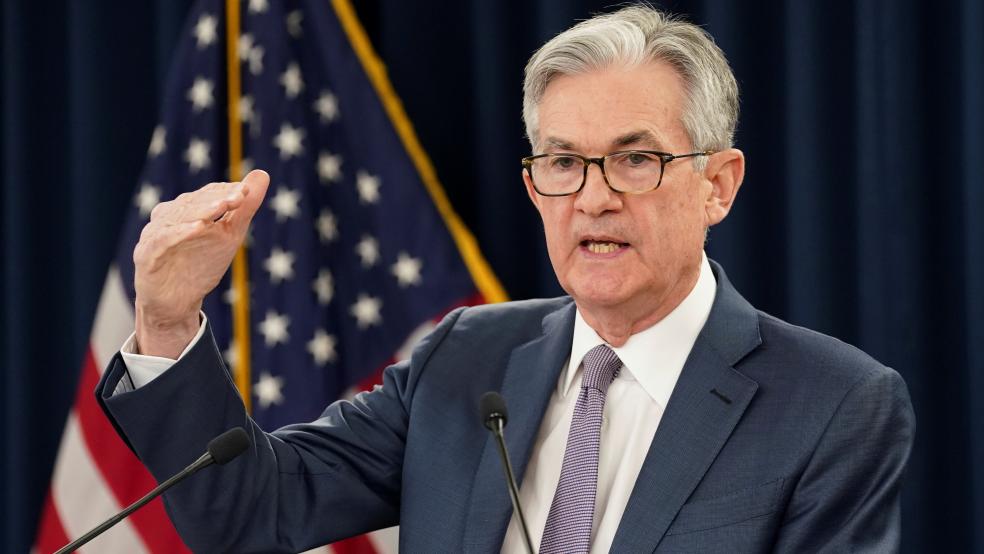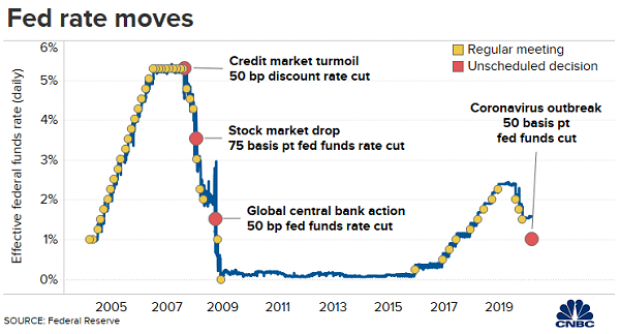The Federal Reserve made it clear Tuesday that it’s deeply worried about the coronavirus and the fear the Covid-19 outbreak has created.
In its first emergency rate cut since the 2008 financial crisis, the Federal Open Market Committee slashed its baseline rate by half a percentage point, dropping it to a range between 1% and 1.25% in an effort to limit the economic damage caused by the virus.
“The Fed typically likes to wait to see hard data signaling economic fires, but the coronavirus is moving so quickly that the central bank felt it needed to act ahead of a widespread situation where workers and students are forced to stay home and the economy grinds to halt,” The Washington Post Heather Long wrote.
Fed Chair Jerome Powell emphasized at a press conference after the rate cut was announced that the fundamentals of the U.S. economy remain strong, but the economic effects of the virus are highly uncertain so the central bank’s rate-setting committee felt it was necessary to act quickly. “We saw a risk to the outlook of the economy and we chose to act,” Powell said. The Fed stands ready to do more if needed, Powell added, “depending on the flow of events.”
Trump presses for more: President Trump wasn’t satisfied by the move. “The Federal Reserve is cutting but must further ease and, most importantly, come into line with other countries/competitors,” he tweeted. “We are not playing on a level field. Not fair to USA. It is finally time for the Federal Reserve to LEAD. More easing and cutting!”
Treasury rates tumble: Investors weren’t impressed by the Fed move, and stocks swooned again Tuesday, with the S&P closing down nearly 3%. The 10-year Treasury yield fell below 1% for the first time ever as investors flocked to the safety of government debt, and the yield on the 30-year Treasury bond hit a record low of 1.601%.
Will rate cuts help? Others have questioned how effective interest rate cuts can be in combatting the economic effects of the virus. The Fed can make it cheaper to borrow money but it can’t develop a vaccine, fix global supply chains or convince anxious Americans that it’s safe to book that trip or head to the mall. “You are not going to slay a disease by lowering interest rates," Bernard Baumohl, chief global economist at The Economic Outlook Group, told the Post.
Powell acknowledged that rate cuts can only do so much and said that the “ultimate solutions to this challenge will come from others, particularly health professionals.” But he said that the emergency rate cut can lift economic activity as well as consumer and business confidence. “We do recognize a rate cut will not reduce the rate of infection, it won’t fix a broken supply chain. We get that,” Powell said. “But we do believe that our action will provide a meaningful boost to the economy.”
The Fed could cut rates again after a regularly scheduled meeting on March 17-18, but some analysts have noted that it has limited room for further cuts, with its target for the federal funds rate now down to between 1% and 1.25%. Powell said Tuesday that the Fed had not discussed using tools besides rate cuts to boost the economy.
That puts the focus firmly on fiscal policy. “The Fed is carrying the burden for everyone else out of ammunition globally, and for the lack of an effective fiscal response,” Julia Coronado of MacroPolicy Perspectives told The New York Times.
Congress still hammering out a deal: Lawmakers are still working on a $7.5 billion emergency package that would provide funds for vaccine development, medical equipment and aid for state and local governments dealing with the coronavirus. The supplemental measure is reportedly being held up by a Democratic demand that test kits, treatments and any eventual vaccine be affordably priced.
Another tax cut? On Monday evening Trump called for Congress to provide a fiscal stimulus to the economy through a temporary cut to the payroll taxes used to fund Social Security and Medicare — the same kind of cut used in the wake of the financial crisis: “The Democrats in the House should propose a very simple one year Payroll Tax cut. Great for the middle class, great for the USA!”
Social Security taxes affect income up to $137,700, so a cut would provide a temporary boost to take-home pay for workers earning up to that level. But House Majority Leader Steny Hoyer (D-MD) reportedly downplayed the chances of such a move. “I don’t think tax cuts are the answer to every problem,” he told reporters.
The Committee for a Responsible Federal Budget took a look at the rough proposal, and estimated that a one-year cut would cost $55 to $75 billion per percent per year.
On the benefits side of the ledger, CRFB relied on a CBO analysis from 2010 that estimated that a 2-percentage point cut to the employee payroll tax over two years would increase economic output by $90 billion to $270 billion over five years. CRFB said that enacting such a cut in 2020 and 2021 would cost $300 billion, excluding interest.
Fiscal stimulus looking more likely: An analysis from the lobbying firm Mehlman Castagnetti Rosen & Thomas said Monday that “significant federal spending is certain.” Finance ministers from the United States, Canada, France, Germany, Italy, Japan and the United Kingdom held a call Tuesday to coordinate response measures and said afterward that they “are ready to take actions, including fiscal measures where appropriate, to aid in the response to the virus and support the economy during this phase.”
Treasury Secretary Steven Mnuchin reportedly said Tuesday that the administration would consider an infrastructure package, tax cuts and other measures if they felt they were needed. And Roll Call reported that Mnuchin and House Ways and Means Chairman Richard Neal (D-MA) have revived discussions of a $1 trillion infrastructure package.
"There's this grand opportunity to talk about infrastructure and make it the serious issue that the country needs and demands,” Neal said Tuesday. “That plan implemented quickly could provide long-lasting stimulus that would go on for decades. A cut in the payroll tax cannot be based on emotion, it's got to be based upon a plan. … And the plan that we offered here today was to proceed with infrastructure.”






